Introduction of PCC Concrete
Important Point
Concrete is a widely used construction material, and when people ask, “what is pcc in construction“, they are referring to the two types of concrete that are generally used in our construction Industry: Reinforced cement concrete (RCC) and Plain cement concrete (PCC).
RCC is reinforced with steel bars whereas PCC ( Plain cement concrete) does not consist of any reinforcing bars in it. It is a mixture of cement, aggregate, and water without reinforcement.
In this article, you will get to know all about What is PCC Concrete and its uses, the ingredients of PCC in construction, and the different methods for mixing of concrete.
What Is PCC Concrete?
The Full form of PCC is ‘Plain Cement Concrete’, often referred to as the pcc full form in civil engineering. Plain cement concrete (PCC) is defined as a mixture of cement, fine aggregate, coarse aggregate, and water without reinforcement.
Plain cement concrete is also known as cement concrete or Binding concrete. Some people also called PCC a Mud Mat ass it is used as a mat before the construction of the foundation.
- What Is Concrete | 31 Different Types of Concrete
- Cinder Block Vs Concrete Block | What Is Cinder Blocks | What Is Concrete Blocks
- Reinforced Concrete Frame | Concrete Frame Construction | Concrete Building Construction | Frame Construction | Types of Frame
- What Is Lightweight Concrete | Properties of Lightweight Concrete | Uses of Lightweight Concrete | Advantages & Disadvantages of Lightweight Concrete
Purpose of Plain Cement Concrete (PCC)
When considering pcc meaning in construction, there are various purposes for which Plain cement concrete is used in the construction, as follows.
- The Plain Cement concrete is laid to prepare a strong impermeable bed for the RCC foundation.
- The plain cement concrete is used to provide a firm layer where the soil is soft and flexible.
- It is spread on the surface of the soil to avoid the direct contact of the reinforcement with soil and moisture that is present in the soil.
PCC Ratio
The PCC Ratio which is generally used is 1:3:6 or 1:4:8.
The PCC concrete mix Ratio of 1:3:6 which means 1 part of cement, 3 parts of sand, and 6 parts of aggregate.
Ingredients of PCC In Construction
When discussing the components of pcc, the main ingredients that are used for making Plain cement concrete are as follows.
- Cement
- Sand (Fine aggregate)
- Coarse aggregate
- Water
1. Cement:
The most commonly used cement in the Plain cement concrete is Portland Pozzolana Cement (PPC). The cement which is used should conform to the standard specifications and all the tests that are carried on cement.
2. Sand (Fine aggregate):
The sand which is used in the Plain cement concrete (PCC) should be cleaned properly, well-graded, dense, hard, sound, and durable. It should not absorb water and should develop a good bond with mortar so that it can provide the required strength.
3. Coarse Aggregate:
The coarse aggregate which is used in the manufacturing of PCC should be clean, dense, and free from dust particles so that it can develop a good bond with cement and achieve the desired strength.
The size of the aggregate that is used in the PCC ranges from 10 mm up to 40 mm. The size of the aggregate used in the plain cement concrete depends upon where it is used.
4. Water:
The water which is to be used in the PCC should be clean and potable and free from harmful materials such as acids, salts, alkalis, etc. The pH value of water that is used in the construction should no be less than 6. The maximum permissible limits should be as per the IS 456:2000.
- Difference Between 33, 43 and 53 Grade Cement
- Difference Between Beam and Column | What Is Beam | What Is Column
- What Is Cover in Concrete | Clear Cover in Beams, Slab, Column, Footing
- Difference Between M25 and M30 Concrete | What Is M25 Grade | What Is M30 Grade
- Difference Between Pre-Tensioning and Post-Tensioning | What Is Prestressed | Methods of Prestress
Making of PCC Concrete
The process of making Plain cement concrete (PCC), or as some might refer to it, the pcc full form in engineering, is as follows.
- Selection of Ingredients required for PCC.
- Mixing of all Ingredients.
- Transportation and placing of PCC.
- Compaction of PCC.
- Finishing of the concrete.
- Curing of concrete.
1. Selection of Ingredients required for PCC:
The Ingredients that are required for making Plain cement concrete such as cement, sand, and aggregate and water are properly selected for making Plain cement concrete in the appropriate ratio that is required to achieve the desired strength of the plain cement concrete (PCC).
2. Mixing of all Ingredients:
All the Ingredients of the plain cement concrete are mixed properly with the help of various Methods for mixing of concrete. All the materials of the plain cement concrete should be mixed properly to form a homogenous concrete.
3. Transportation and Placing of PCC:
The transportation and placing of the concrete are one of the important stages in which the concrete is transported and placed at the required place as fast as possible.
The concrete which is mixed then transported and placed either by manually in an iron pan or mechanically with the help of the wheelbarrow or by transit mixers if the construction site is far.
The mode of transportation that is used in the for concrete depends upon the nature of the work and the size of the project.
4. Compaction of PCC:
Compaction of Plain cement concrete is done to remove air voids and make the concrete denser and more compacted. There are various tools and instruments are used such as rods and vibrators for the proper compaction of the concrete.
Needle vibrator or surface vibrator is used for the compaction of the concrete.
5. Finishing of the Concrete:
The concrete is finished properly by removing the irregularities and voids that are present on the surface.
6. Curing of Concrete:
Curing is most important to achieve the desired strength of the concrete. Curing of the concrete is done with various methods such as ponding or by applying wet gunny bags.
Methods for Mixing of Concrete
Mixing of the concrete is very important to make a homogeneous mixture of the concrete to achieve the desired strength of the concrete.
The production of concrete is the process of making different types of ingredients such as cement, sand, aggregate and water in an appropriate proportion.
The process of the mixing of the concrete is very time-sensitive, once the dry mix of the concrete is added with water then it should be quickly mixed and placed at the site as soon as possible.
The workers have to place the concrete and compact it before it gets hardens. Nowadays the concrete is prepared at the concrete plant for the projects where the concrete is required in a large quantity.
There are mainly three types of Concrete mixing types that are used in the production of good quality of concrete are as follows.
- Hand Mixing of the Concrete.
- Machine Mixing of the Concrete.
- Ready Mix Concrete.
1. Hand Mixing of Concrete:
Hand Mixing is the traditional method of mixing of concrete ingredients without help of any mixer or machine. This method of mixing is usually used only for small works where the quality control of the concrete is less important.
The uniformity of the concrete is very difficult to achieve in the case of the hand mixing of the concrete.
Process of Hand Mixing of Concrete
The step-by-step method that is used in the hand mixing of the concrete are as follows.
- The Hand mixing of the concrete should be done on a rigid, clean, and non-porous surface so that there will not be any loss of water from the mix of the concrete.
- Use the measurement boxes for the batching of various ingredients of the concrete.
- First upon, the dry mix of the concrete is prepared by mixing all the ingredients of concrete except water.
- The measured amount of water then added at the center of the dry mix of the concrete and mix the concrete properly so that the uniform concrete mix will be formed.
- Add water in the dry mix step by step and in a very slow manner. Don’t add full water as it will flow out and the concrete with required consistency will not be formed.
- Mix all the materials for at least 3-5 minutes until a uniform homogenous concrete mix will not be formed.
Precautions to Be Taken During Shaking the Concrete
- The base platform at which the concrete is mixed and prepared should be clean and should not absorb water.
- The tools and equipment which are used in the mixing of the concrete should be clean and in good working condition.
- The aggregate should not contain any kind of dirt and debris, if there any impurities present wash it properly.
- The labors should wear all the safety equipment while working on site.
- The platform at which the concrete is mixed should be cleaned at end of the day.
2. Machine Mixing of Concrete:
In this process of mixing of concrete, all the ingredients of the concrete are mixed with the help of a mixer machine. The concrete mixing with the help of mixer machine takes very less time and gives quality and properly mixed concrete.
Process of Machine Mixing of Concrete
Process of mixing of concrete through concrete mixer machine are as follows.
- Firstly, the internal surface of the concrete mixer is sprinkles with water.
- The coarse aggregates are added in the concrete mixer which are followed by the sand and then cement.
- The ingredients are mixed dry in the concrete mixer for approx. 2 min to 5 min.
- After proper mixing of the ingredients in the dry state, the water is added slowly in the appropriate amount.
- Do not add extra water as it will reduce the strength of the concrete.
- After adding water in the concrete, the concrete should be mixed for at least 2 minutes so that the homogenous concrete will be formed.
Precautions to be taken while mixing concrete through concrete mixer machine
- The concrete mixer should be made wet before using it.
- The time, speed and the number of revolutions of the concrete mixer drum should be followed as per given by the manufacturers of the mixer machine.
- The concrete should be used within 30 minutes after mixing and discharging from the concrete mixer.
- If the concrete mixer is of continuous type, then it is necessary that the mixer should be clean at a fixed interval of time.
- The internal part of the concrete mixer should be inspected regularly to check whether there any damages to it.
3. Ready Mix Concrete
Ready-mix concrete is a modern type of method which is used widely in the construction industry. It is mostly used in the construction of high-rise buildings and other Mega-projects.
In this type of method, the quality control of the concrete is achieved and the concrete can be prepared as per the required specifications. This method of mixing is best suitable for construction sites where no space is available for the mixing of the concrete.
The concrete that is prepared through the Ready-mix method is of High-quality standards and the water-cement ratio can be easily maintained as compared to the other types of mixing methods. The Ready-mix concrete is transported with the help of the transit trucks to the construction site.
Factors Affecting Method of Mixing of Concrete
There are various factors that affect the mixing of the concrete are as follows.
- Location of the construction site also affects the method of the mixing of the concrete.
- Volume of the concrete required for the construction also governs the type of method mixing to be used on the site.
- The method of concrete mixing is also affected by the cost of the construction project.
- Height at which the concrete is to be placed.
- Nature of the work for which concreting work is to be done.
Work Procedure of PCC Construction
The work procedure for the construction of the Plain cement concrete are as follows.
- All the materials that are required for making PCC are selected. The batching, mixing, placing and compacting is done.
- The required cement, sand and aggregates are taken as per the required proportionate quantities and form a depo.
- It is recommended to dump a depo required for a half bag for better and uniform mixing of all the ingredients.
- Firstly, mix the dry depo properly with the help of the spade and ensure that the all ingredients are mixed properly.
- Add the required quantity of water in the mixture and mix it properly to make the concrete workable.
- Place the concrete at the required location. The Plain cement concrete is directly placed to the required place by the means of labors or pump depending upon the nature of the construction work.
- The concrete should be compacted properly with the help of steel rod or vibrator depending upon the depth of the PCC.
- The sides of the shuttering should be properly tamped and finished with the help of Thapi in order to get a smooth and uniform finish after de-shuttering.
Also, Read: Bolt Vs Screw | What Is Bolt | What Is Screws
Uses of PCC Concrete
When considering pcc meaning construction, the various applications of Plain cement concrete are as follows.
- Plain cement concrete (PCC) is mainly used for the foundations of the structures.
- PCC provides a leveled surface for the construction of the footings.
- Plain cement concrete is also used for making Tennis courts, Basketball courts etc.
- It is also used in construction of the storm or sewer on drains.
- Plain cement concrete avoids the direct contact of the foundation with soil and moisture.
- PCC is used for the construction of the pavements and the protection of Plinth.
- It is also used for concrete coping over the parapet walls as well as compound walls.
PCC Concrete Grades
The PCC Concrete Grades, or as some might refer to as the pcc full form civil, that are generally used in the Plain cement concrete are M5, M10, M15 in the construction works such as leveling and Bed footing.
The minimum grade of concrete that is used for PCC work is of M10.
Different Grades of concrete that are used are as follows.
- Normal Grade of Concrete
- Standard Grade of Concrete
- High Strength of Concrete
1. Normal Grade of Concrete
|
Concrete Grade |
Mix ratio | Compressive Strength in N/mm2 |
Psi |
|
M5 |
1:5:10 |
5 MPa |
725 psi |
|
M7.5 |
1:4:8 |
7.5 MPa |
1087 psi |
|
M10 |
1:3:6 |
10 MPa |
1450 psi |
|
M15 |
1:2:4 |
15 MPa |
2175 psi |
|
M20 |
1:1.5:3 |
20 MPa |
2900 psi |
Generally, M5, M10, M15 grades of concrete are used for the Plain cement concrete work.
- Standard Grade of Concrete
- The Standard Grade of concrete are M25, M30, M 35 which are used in the Reinforced cement concrete (RCC) works.
Unit weight of Plain Cement Concrete (PCC) = 2400 kg/m3
Unit weight of Reinforced cement concrete (RCC) = 2500 kg/m3
- M20 grade of concrete is usually used for the construction of the Reinforced cement concrete (RCC) for the construction of the slabs, beams, columns, and footings etc.
- M45 and M50 grade of concrete is also used in the construction of the runways, prestressed concrete girders, and prestressed beams etc.
Also, Read: What Is Bridge Abutment | 5 Types of Abutments
2. High Strength Concrete
The High Strength of concrete grades that are used in the construction are as follows.
| Concrete Grade | Mix ratio | Compressive Strength in N/mm2 | Psi |
| M50 | Design Mix | 50 MPa | 7250 psi |
| M55 | Design Mix | 55 MPa | 7975 psi |
| M60 | Design Mix | 60 MPa | 8700 psi |
| M65 | Design Mix | 65 MPa | 9425 psi |
| M70 | Design Mix | 70 MPa | 10150 psi |
This are the High strength concrete grades that are used in the construction of the High Rise Buildings, long span bridges etc.
Do’s and Don’ts of PCC Works
1. Do’s for the construction work of Plain cement concrete
Before doing PCC in the foundation the soil strata present at the site should be approved by the Structural Consultant. The shuttering of the PCC should be of exact size and thickness.
A Dry mix of PCC should be uniformly mixed before adding water to it. The water should be added as per the water-cement ratio in a measured quantity.
Use the chute or additional labor for pouring the concrete where the depth of the foundation is more. The loose material in the pit of the foundation should be removed before starting the construction of PCC.
If the water table in the pit is high then it should be dewatered before concreting. The proper compaction of the PCC should be done and the level should be maintained properly.
2. Don’ts for the construction work of Plain cement concrete
Do not mix the materials on the bare land. Do not directly add water into the dry mix of PCC without measuring its quantity. Do not pour the PCC over the soil without its proper compaction and leveling.
Do not allow PCC without Formwork. There should not be an excessive amount of cement on the Top surface of plain cement concrete.
Advantages of PCC Concrete
There are various advantages of Plain cement concrete (PCC) in the construction of the structures that are as follows.
- Plain cement concrete provides a rigid Impervious bed for the construction of the foundation.
- PCC helps to provide a level to foundation construction and avoid unequal settlement of the foundation.
- It also helps to avoid direct contact of the foundation reinforcement with the soil which may cause dampness due to the action of capillarity.
- The required coverage for the lower reinforcement of the RCC foundation is ensured as the cover blocks rest on the firm Plain cement concrete.
- It forms a barrier and avoids direct contact with the reinforcement due to the corrosion of the reinforcement is restricted.
- It provides ease in the placement of the Steel cages and increased productivity.
Also Read: Mortar Definition Construction
Disadvantages of PCC Concrete
There are also some disadvantages of Plain cement concrete that are as follows.
- The Tensile strength of the Plain cement concrete (PCC) is very low as it does not consist of reinforcement.
- Due to low Tensile Strength, there may be chances of the development of cracks in the PCC.
- It required adequate curing till hydration to achieve the desired strength of the concrete.
PCC Concrete
Portland cement concrete (PCC) pavements (or rigid pavements) consist of a PCC slab that is usually supported by a granular or stabilized base, and a subbase. In either case, the PCC is then dumped, spread, leveled, and consolidated, generally using concrete slip-form paving equipment.
What Is RCC and PCC?
Plain cement concrete (PCC) is simply concrete by definition. Reinforced cement concrete (RCC) is PCC + reinforcement. The reinforcement is generally steel bars bent and laid into the desired shape and orientation. The reinforcement can be both tensile or compressive reinforcement depending upon the situation.
What Is Difference Between Lean Concrete and PCC?
The main difference between lean and PCC concrete is that lean concrete contains less cement compared to the water content present in it. This means, when compared to plain cement concrete (PCC), the lean concrete has a smaller ratio of cement to water content.
PCC Material
PCC full form is plain cement concrete. It is a mixture of cement, sand, aggregate and water without reinforcement. PCC Concrete is spread on the soil surface before concreting maid structure to avoid direct contact of reinforcement of concrete with soil and water.
PCC in Construction
The term PCC stands for plain cement concrete. The mixture of cement, fine aggregate (sand) and coarse aggregate are generally called plain cement concrete (PCC).
What Is the Ratio for PCC?
PCC concrete mix ratio is 1:5:10, which Means 1 part of cement, 5 parts of sand, and 10 parts of aggregate. PCC in construction is used to make a level bed for footing.
Where Is PCC Concrete Used?
Some of the uses of plain cement concrete are: a. It is commonly used in the construction of the column foundation, massive gravity dams, flooring, etc.
Which Is Better PCC or RCC?
In terms of strength, naturally, RCC is stronger because the reinforcement helps in load-carrying capacity. PCC is weaker and is only used for layering surfaces like plastering work or flooring and most importantly in the layering if excavation to cast footings.
Why Do We Give PCC?
The main reason of providing PCC is to provide a rigid impervious bed to RCC in the foundation before starting any RCC or masonry work directly on the excavated soil, PCC is done to form a leveled surface and to avoid laying concrete on soil directly so as to avoid mixing with soil and also to prevent soil extracting.
Which Cement Is Best for PCC?
For PCC concrete works, generally, M15 is used. For reinforced concrete construction minimum M20 grade of concrete is used. The concrete admixture ratio is the ratio of its components such as cement, sand, aggregate, and water.
Which Grade Cement Is Best for PCC?
Here, best PCC cement list are as follows.
| Sr.No. | Best for PCC | Price |
| 1 | UltraTech cement | 390 |
| 2 | Shree Cement | 280 |
| 3 | Ambuja cement | 280- 375 |
| 4 | Ramco cement | 285 |
| 5 | JSW Cement | 330 |
| 6 | Binani cement | 270 |
| 7 | Dalmia Cements | 240 |
| 8 | Birla cement | 295-350 |
| 9 | J.K. Cements | 270-350 |
| 10 | The Indian Cement | 350 |
Which Grade Cement Is Used for PCC?
The Grade of the PCC used is M15 grade. IN M15 Grade, The mix ratio is 1:2:4. (1 cement,2 sand, 4 aggregates). Applications: M15 grade plain concrete cement is used for levelling courses, bedding for footing, beams, and columns etc.
Why Is PCC Used in Construction?
The main reason of providing PCC is to provide a rigid impervious bed to RCC in the foundation before starting any RCC or masonry work directly on the excavated soil, PCC is done to form a leveled surface and to avoid laying concrete on soil directly so as to avoid mixing with soil and also to prevent soil extracting.
PCC Construction
The term PCC refers to Plain Cement Concrete. A mixture of cement, fine aggregate (sand), and coarse aggregate without reinforcement. PCC concrete is used to provide a firm base on the soil before laying main structural elements of the building.
Like this post? Share it with your friends!
Suggested Read –
- Gravity Dams
- Steps of Construction
- What Is Shoring In Construction | Type of Shoring
- Concrete Vs Cement | What Is Cement | What Is Concrete
- 10 Mortar Vs Concrete | What Is Mortar & Concrete | Types of Mortar & Concrete
- Load Bearing Wall Construction | How to Tell If a Wall Is Load Bearing | Load Bearing Beam | Non-Load Bearing Wall | Non-Load Bearing Wall Framing
- What Is Shotcrete | Shotcrete & Concrete | Shotcrete Technology | Types of Shotcrete Technology | Advantages of Shotcrete | Disadvantages of Shotcrete
- Definition of Shear Force and Bending Moment | What Is Shear Force | What Is Bending Moment | Relation Between Loading, Shear Force & Bending Moment


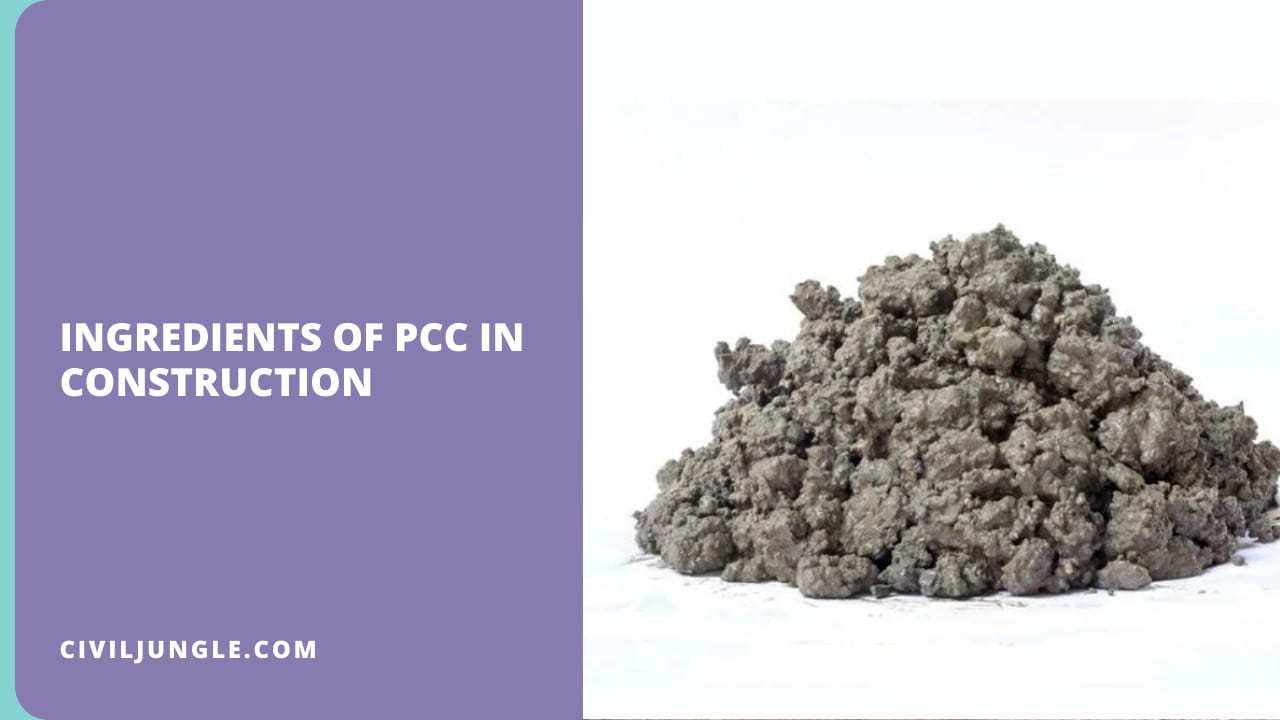
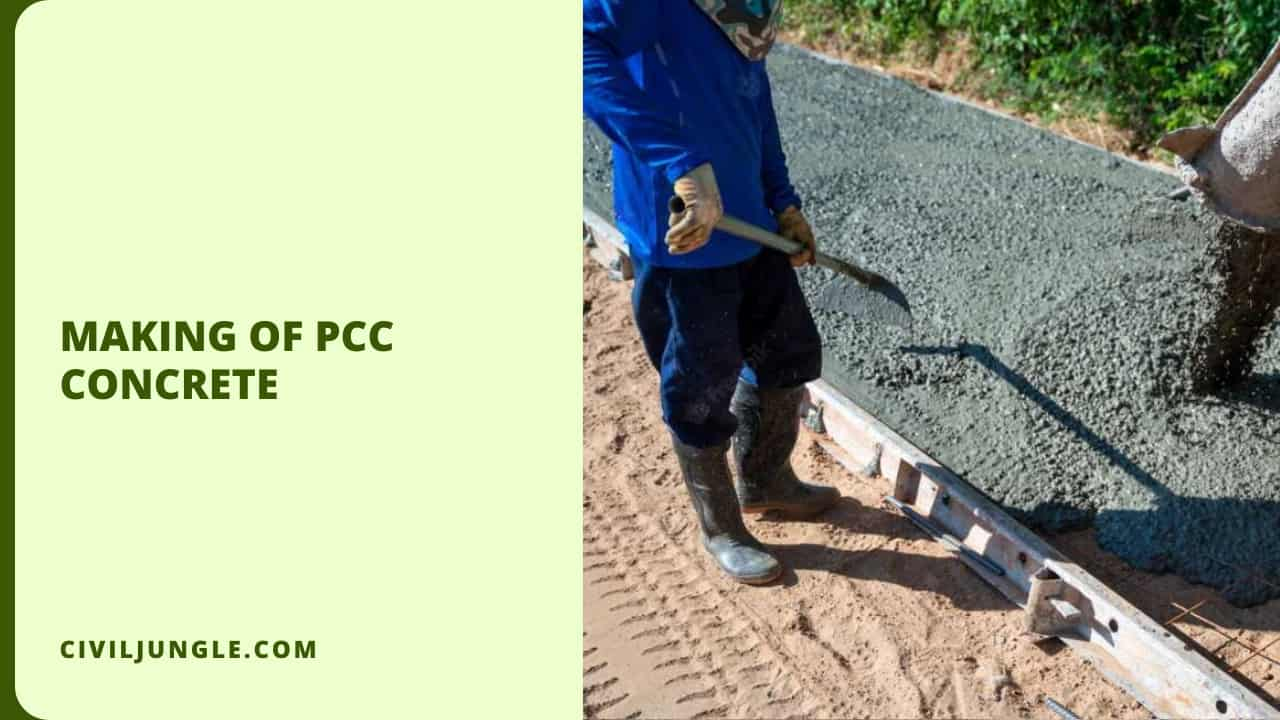
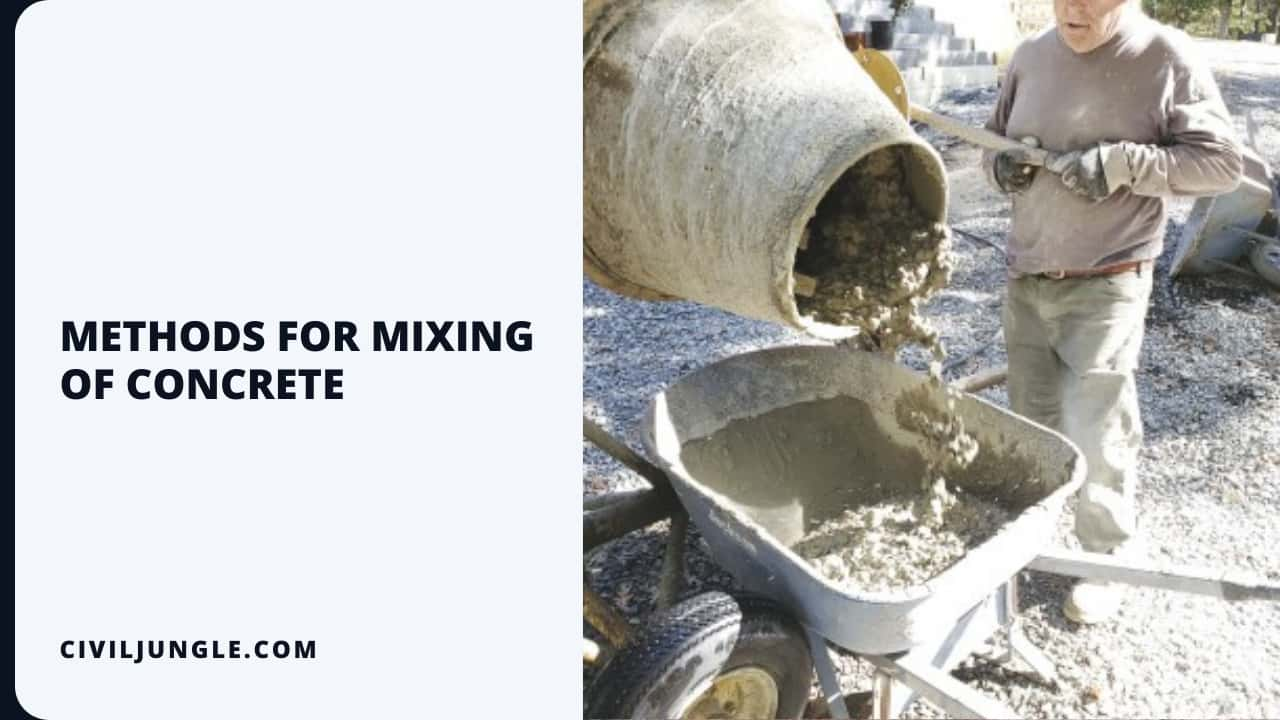
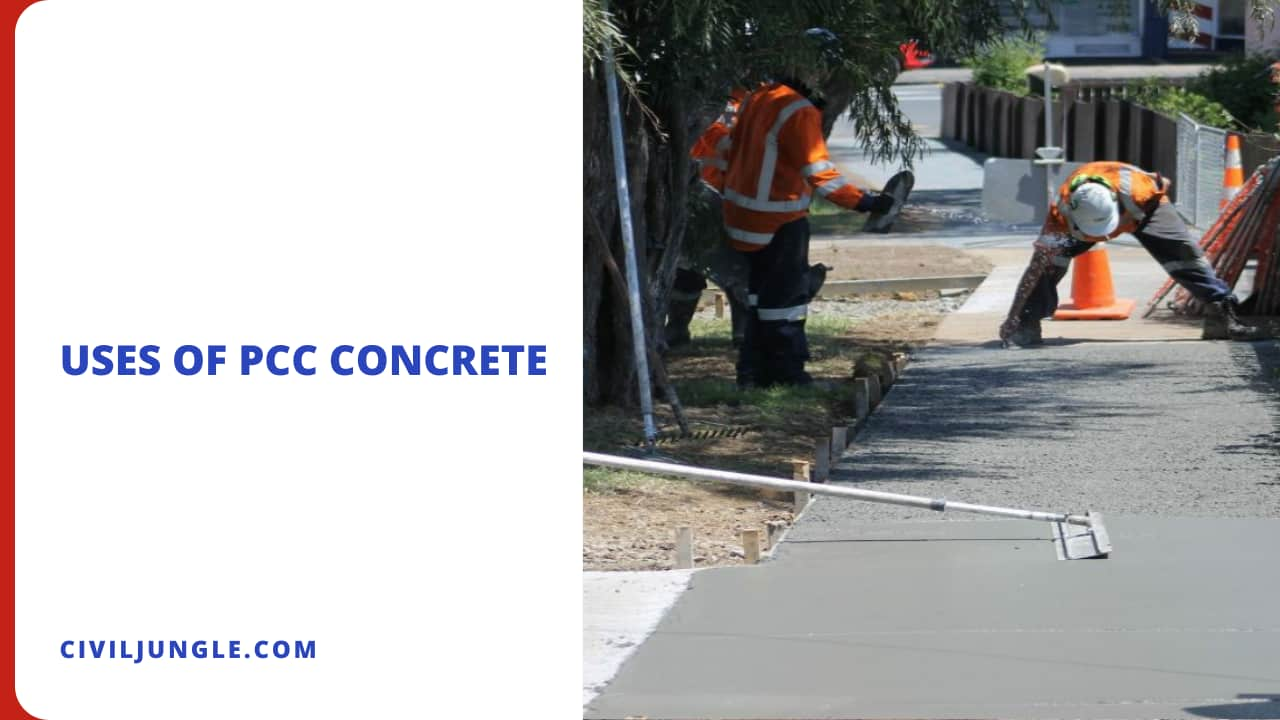
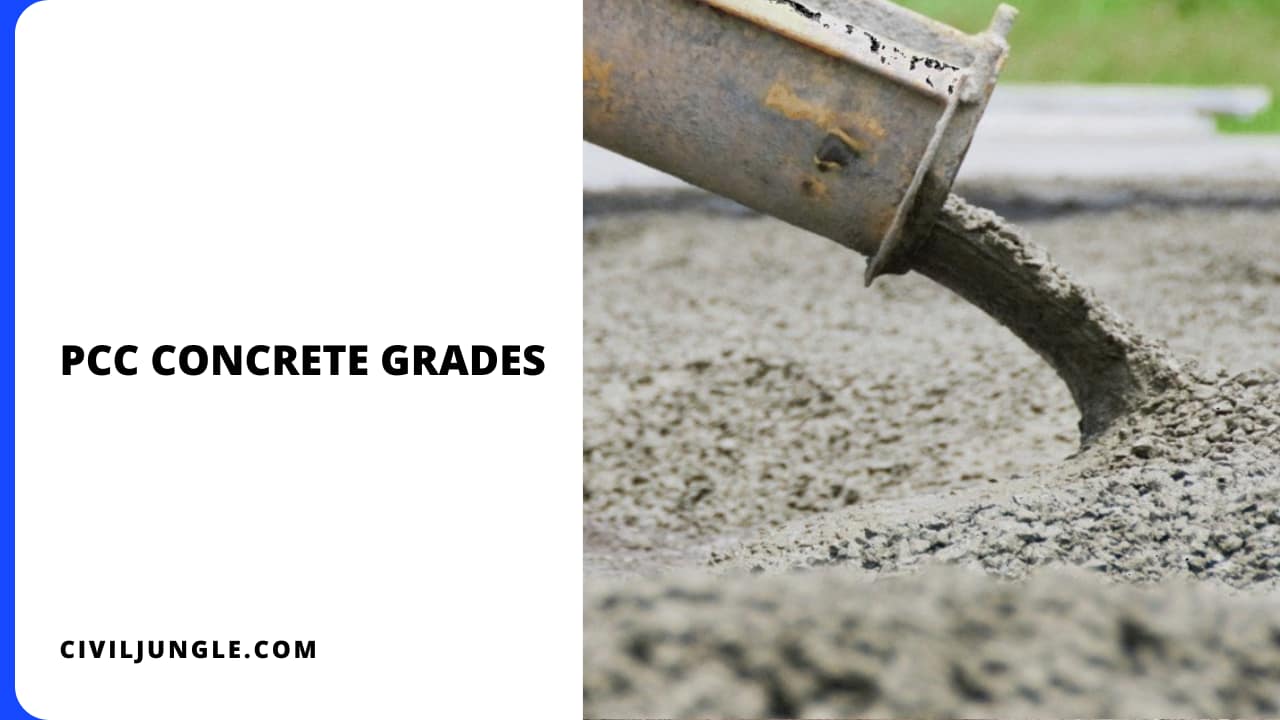

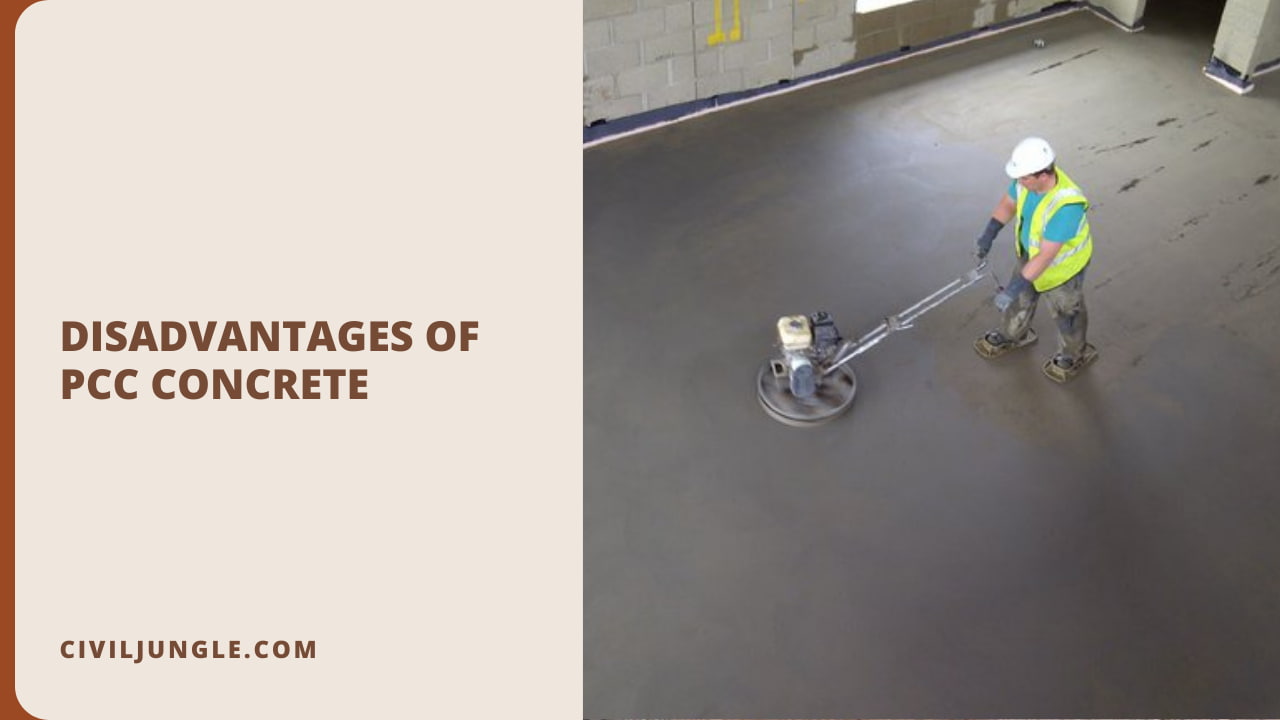

Leave a Reply